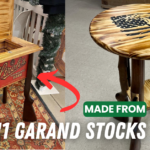I. Understanding the Value of Upcycled Furniture in the UK
II. Factors Influencing Pricing: Materials, Labor, and Market Demand
III. Pricing Strategies: How to Set Competitive Rates for Upcycled Furniture
Understanding the Value of Upcycled Furniture in the UK
Have you ever walked into a room filled with unique furniture pieces that each tell a story? That’s the magic of upcycled furniture! In the UK, this trend has taken off, and for good reason. Let’s dive into why upcycled furniture holds such great value, not just for your home but also for the planet.
What is Upcycled Furniture?
Before we get into its value, let’s clarify what upcycled furniture is. Upcycling involves taking old or discarded items and transforming them into something beautiful and functional. This could mean turning an old wooden pallet into a stylish coffee table or refurbishing a vintage chair with a fresh coat of paint and new upholstery.
The Environmental Impact
One of the most significant values of upcycled furniture is its positive impact on the environment. Here are some factors to consider:
- Reducing Waste: Upcycling helps divert furniture from landfills, where it contributes to environmental pollution.
- Conserving Resources: By reusing materials, we lessen the demand for new resources, which helps conserve forests and reduces carbon emissions associated with manufacturing.
- Promoting Sustainability: With a growing awareness of climate change, many consumers are actively seeking sustainable options, and upcycled furniture fits right into that ethos.
A Unique Aesthetic
Upcycled furniture is not just eco-friendly; it’s also incredibly stylish. Each piece boasts a unique look, ensuring that your home stands out from the crowd. Here’s why this individuality appeals to so many:
- Character and Charm: Upcycled items come with a history that can evoke nostalgia or inspire conversations.
- Customizability: Many upcyclers pour their creativity into each piece, allowing you to choose colours, textures, and styles that fit your personal taste.
- One-of-a-Kind Finds: Unlike mass-produced furniture, upcycled items are often unique, so you won’t find someone else with the same piece in their home.
Supporting Local Artisans
When you purchase upcycled furniture, you often support local artisans and small businesses. This creates a sense of community and encourages craftsmanship. Here’s how:
- Celebrating Local Talent: Many skilled artisans specialize in upcycling, and buying their pieces helps sustain their craft.
- Encouraging Creativity: Supporting these creators fosters an environment where innovation thrives, leading to even more unique furniture solutions.
Cost-Effectiveness
Although upcycled furniture can sometimes come with a higher price tag due to the labor and creativity involved, it can still be a cost-effective choice in the long run. Consider the following:
- Durability: Many upcycled pieces are made from high-quality materials that stand the test of time.
- Investment Value: Unique items can appreciate in value, especially if they showcase exceptional craftsmanship or design.
In conclusion, upcycled furniture in the UK represents much more than just a trend; it embodies a lifestyle choice that values sustainability, creativity, and individuality. By choosing these unique pieces, you’re not only enhancing your home but also making a positive impact on the world around you.
Factors Influencing Pricing: Materials, Labor, and Market Demand
When it comes to pricing upcycled furniture, several key factors come into play. Understanding these variables can help you make informed decisions, whether you’re a buyer looking for a great deal or a seller aiming to set the right price. Let’s break it down!
1. Materials
The type of materials used in upcycled furniture significantly influences its price. Here are a few things to consider:
- Quality of Materials: High-quality wood, metal, or fabrics will naturally cost more. If the furniture has been crafted from reclaimed teak or oak, for instance, expect a higher price tag due to the durability and appeal of these materials.
- Source of Materials: Locally sourced materials can be cheaper and more sustainable, but if you’re using exotic or rare materials, this can drive up costs considerably.
- Finishes and Treatments: The type of paint, stain, or finish applied also affects pricing. Eco-friendly finishes might add to the cost but can attract a more environmentally conscious clientele.
2. Labor
Next up is the labor involved in transforming old furniture into something new and beautiful:
- Time Investment: The more time and effort put into upcycling, the higher the price. A piece that’s meticulously sanded, painted, and crafted will be worth more than a quick refurb.
- Skill Level: If a skilled artisan is behind the project, their expertise can significantly increase the value of the furniture. It’s like buying a piece of art; you’re not just paying for the materials but also the talent and creativity involved.
- Complexity of Design: Unique designs or intricate work will naturally demand a higher price than straightforward, simple pieces. Custom designs tailored to a client’s taste can also boost the pricing.
3. Market Demand
Last but not least, market demand plays a huge role in pricing upcycled furniture:
- Trends: If upcycled furniture is trending, prices may go up as more buyers seek out these unique pieces. Stay informed about current design trends to gauge the best times to sell.
- Location: The geographical area affects how much you can charge. Urban areas with a higher cost of living may support higher prices compared to rural locations.
- Consumer Awareness: As more people become aware of sustainability and eco-friendly practices, demand for upcycled furniture increases. Educating your audience about the benefits of upcycling can create a stronger market.
In summary, pricing upcycled furniture is an art in itself! By considering the materials used, labor involved, and market demand, you can set appropriate prices that reflect the true value of these unique pieces. Whether you’re diving into the world of upcycled furniture as a consumer or a creator, understanding these factors will arm you with the knowledge you need to navigate this vibrant market. Happy upcycling!
Pricing Strategies: How to Set Competitive Rates for Upcycled Furniture
Setting the right price for your upcycled furniture can feel like a balancing act. You want to be competitive, but you also want to make sure you’re valuing your hard work and creativity. Let’s dive into some effective pricing strategies to help you navigate this exciting market!
1. Know Your Costs
Before you even think about pricing, it’s crucial to understand your costs. Here’s what to consider:
- Materials: Calculate the cost of any paint, fabric, or hardware you’ve used. Even small items can add up!
- Labor: Factor in the time you spent on each piece. This might be trickier to quantify, but consider what you’d like to earn per hour.
- Overhead: Don’t forget about utilities, tools, and workspace! All these contribute to the final cost.
Once you have a good grasp of what it costs you to create your pieces, you can move on to pricing with confidence.
2. Research the Market
Next up is market research! Taking the time to explore what similar pieces are selling for can give you valuable insights. Here’s how to conduct effective research:
- Browse Online Platforms: Sites like Etsy, Facebook Marketplace, or eBay can offer a wealth of information about current pricing trends.
- Local Stores: Visit local shops that sell upcycled furniture. Take notes on their pricing, styles, and customer appeal.
- Talk to Other Upcyclers: Networking with fellow upcyclers can provide insights on what works and what doesn’t in terms of pricing.
Remember, just because something is priced high doesn’t mean it will sell. Look for pieces that have sold successfully and analyze their prices.
3. Consider Your Unique Selling Proposition (USP)
Your unique selling proposition is what sets your work apart. If you specialize in a particular style or technique, don’t shy away from highlighting that! For example, if you have a talent for turning old wood into stunning farmhouse tables, you can often justify a higher price due to your specialized skills.
Here are some questions to reflect on:
- What makes your designs unique?
- Are you using eco-friendly materials?
- Do you offer customizations?
By clearly defining and communicating your USP, you can justify your pricing to potential buyers.
4. Test and Adjust
Finally, don’t be afraid to test your pricing. Start with an initial price based on your research and costs, and then be open to adjustments based on customer feedback and sales performance. Here are some tips for testing:
- Run Promotions: Consider offering a discount or a special promotion to gauge interest at different price points.
- Track Your Sales: Take note of which items sell quickly and which ones linger. This feedback is invaluable for future pricing.
- Gather Customer Feedback: Don’t hesitate to ask your customers their thoughts on pricing. Their input can guide your future strategies.
With these strategies in hand, you’ll be well-equipped to set competitive rates for your upcycled furniture. Remember, pricing is not just about numbers; it’s about communicating the value of your creativity and craftsmanship. Happy upcycling!










Comments